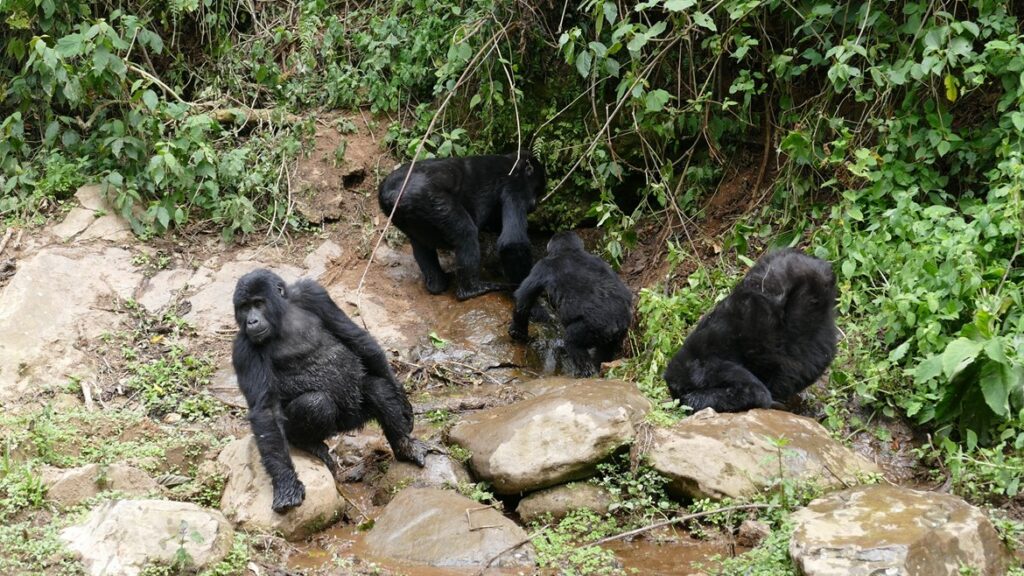How Climate Change Affects Gorilla Habitats
Climate change slowly reshapes the forests of the Virunga Mountains, and its influence reaches every corner of the gorilla habitat. Mountain gorillas depend on stable weather, predictable vegetation cycles, and balanced forest systems. When climate patterns shift, the forest responds in ways that affect food availability, water flow, habitat structure, and even disease risks. These changes unfold gradually, yet they carry long-term consequences that conservation teams watch closely. Understanding how climate change alters gorilla habitats helps us appreciate the urgency of protecting these fragile ecosystems.

Rising Temperatures Changing Forest Zones
Mountain gorillas live comfortably in cool, high-altitude forests. As temperatures rise, vegetation zones begin to shift. Plants that once thrived at certain elevations gradually move higher, and gorillas must adjust their feeding routes to find familiar foods. Warmer temperatures also dry out sections of the forest, especially during extended dry spells. These shifts force gorilla families to explore new areas, which sometimes brings them closer to boundary zones where human activity increases. Rangers observe these changes every year, and they adapt their monitoring strategies to guide protection efforts.
Altered Rainfall Patterns Affecting Food Supply
Rain governs the growth of bamboo shoots, wild celery, roots, and herbs that gorillas depend on. Climate change disrupts rainfall patterns, causing heavier downpours in some months and longer dry periods in others. When rain becomes unpredictable, the growth cycles of plants change. Some seasons bring shortages of young vegetation, while others produce sudden bursts of food that alter gorilla movement. Families must travel farther to find their preferred plants, and this increased movement affects their energy levels and social rhythms. Unstable rainfall also impacts soil quality, making certain feeding grounds less productive.
Increased Stress on Habitat Boundaries
Climate change places more pressure on the edges of the park. When vegetation patterns shift or dry periods extend, gorilla families sometimes move closer to community farmland seeking greener patches. This movement increases the risk of human–wildlife conflict. Farmers worry about crop damage, while conservation teams focus on preventing harmful encounters. Reforestation programs grow more urgent as they restore degraded buffer zones and give gorillas safer, more continuous habitat areas. Climate stress makes these restoration efforts essential to the long-term balance between wildlife and human settlement.
Higher Disease Risks for Gorillas
Warmer temperatures and unstable seasons create new challenges for gorilla health. Changes in climate influence the presence of insects, parasites, and pathogens that thrive under hotter or wetter conditions. Gorillas share close genetic links with humans, and climate stress increases the risk of disease transmission between species. Conservation veterinary teams monitor gorilla families daily to track early signs of illness, especially in seasons when insects and moisture levels rise. Climate change complicates this work by creating new patterns of environmental stress that did not exist years ago.
Impact on Water Sources and Forest Moisture
Water plays a quiet but essential role in gorilla habitat stability. Streams, wetlands, and moisture-rich zones support the plants gorillas feed on. Climate change alters this balance by reducing water flow in some months and increasing runoff during heavy rains. Drier seasons shrink key feeding zones, while stronger storms erode soil and strip nutrients from the forest floor. These shifts affect how gorillas move through the landscape and where they choose to feed. The forest responds slowly, but conservation teams already notice changes in moisture patterns.
Why Protection Efforts Grow More Urgent
Climate change adds new pressure to a conservation system already working hard to protect an endangered species. Rangers, researchers, and community partners adapt their strategies to keep habitats steady and resilient. Reforestation, anti-poaching patrols, disease monitoring, and community education all strengthen the forest’s ability to cope with climate shifts. Each action helps stabilize the landscape and gives gorilla families the space, water, and food they need to survive in a warming world.
Hope Through Conservation and Community Support
Even as climate change affects the forest, Rwanda continues to lead strong and proactive conservation efforts. Community involvement, habitat restoration, and careful tourism management help reduce pressure on the ecosystem. The resilience of the gorillas, combined with human commitment, creates hope for the future. The forest continues to regenerate, and conservation teams adapt with creativity and dedication. Climate change remains a challenge, but Rwanda’s united response shows how people and wildlife can face it together.
Plan a Trek That Supports Habitat Protection
When you visit Rwanda, your gorilla permit contributes directly to conservation work that strengthens the habitat against climate stress. Your journey supports rangers, researchers, and community programs that protect the future of the species.
Inquire and book your Rwanda gorilla trekking experience at https://www.gorilla-permits.com.

